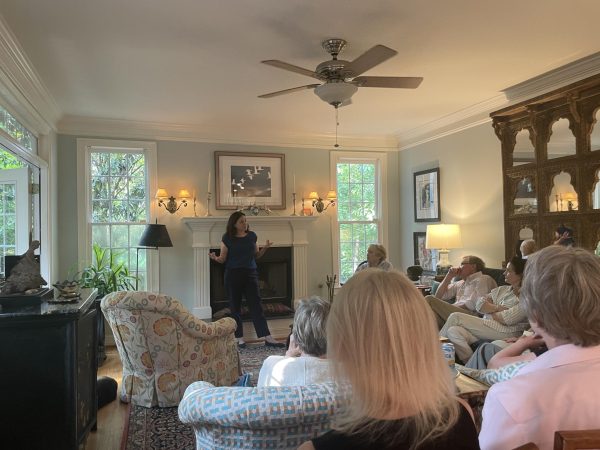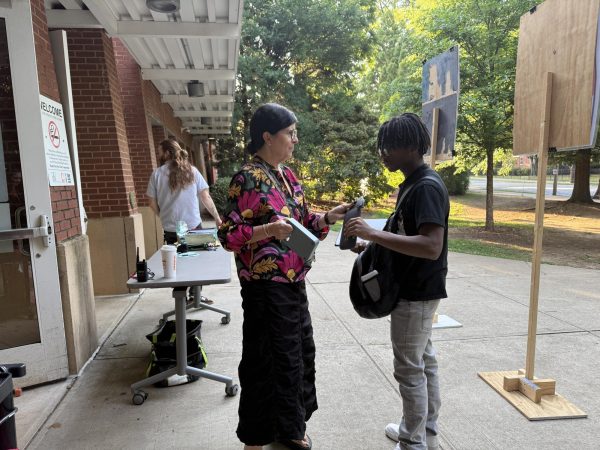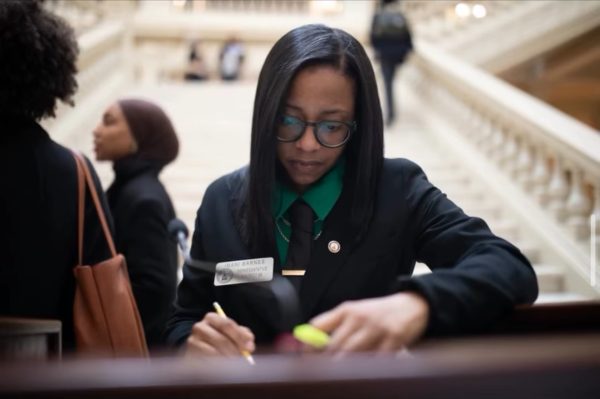SLC struggles to create new law pathways
By Isabelle Taft
On the first day of the 2010-2011 school year, four new small learning communities opened their doors to Grady freshmen. On its first day, however, the Public Policy & Justice Academy had a problem: it was required to offer students a choice of two “pathway” courses, sequences designed to give students skills they can apply to particular careers or fields of study. APS, however, had not hired a teacher with a background in law or public policy to teach those classes. Instead, Mary Carter Van Atta, a world geography and civics teacher, was forced to teach introductory courses for the law-based pathway.
“It was very demanding because I’m not a lawyer, so I had to rely on a lot of outside sources,” Van Atta said. “It was an intro class so it wasn’t a big deal, but it would have been a big deal had I had to do anything with the more advanced classes.”
The following school year, APS hired a trained lawyer to teach the law pathway courses. But academy leader Russell Plasczyk said hiring pathways teachers has continued to be a problem, with significant turnover in the law-pathways teacher position. Since the public policy pathway has not materialized, the academy was renamed Law and Leadership this year. Instead of a complete second pathway, Law and Leadership students pay participate in JROTC, a situation Plasczyk calls “one-and-a-half pathways.”
Plasczyk said he hopes to develop a second curricular pathway, but since hiring a teacher continues to pose problems, JROTC is the best alternative. He recognizes, however, that it lacks the broad appeal of a pathway unique to the academy.
“[APS] said they’re going to roll out four equal academies, but you can’t be equal if one has no pathways,” Plasczyk said.
LOSING THEIR PATHWAYS
The groundwork for each SLC was laid more than three years ago by committees of teachers, parents and students, with input from APS officials. The reorganization was part of a systemwide transition to the small-school model; Grady was one of the last to make the switch. Each academy was designed to offer students a choice of “career, technical and agricultural education” pathways to prepare them for college and the work force.
The C&J academy, closely modeled on the defunct magnet program, has three pathways and offers additional options within each pathway. The Biomedical Sciences and Engineering academy has two pathways, one of which has existed at Grady for years as the HOSA program. The Business and Entrepreneurship academy offers three pathways, building off a fashion program and courses in business principles.
Plasczyk said APS should have allocated resources to provide more support for academies, including L&L, which were starting without older programs to build upon.
“I think someone would say, look at the academies, look at the pathways, and if you have an academy without pathways, put money there,” Plasczyk said.
Carrie MacBrien, C&J academy leader, also led the former communications magnet. MacBrien listed seven faculty members who teach pathways classes, often in addition to core classes or other electives, for a total of nearly 20 class periods offered as pathway courses and electives to C&J students.
Classes in the law pathway are taught by Henry Bowden, a Grady parent with a background in law who has been hired as a long-term substitute to teach with Calethea Barbour. Bowden, who is currently serving as a municipal judge in East Point, started teaching full-time at the beginning of the second semester.
“We discuss the law via applications to the real world, kind of open it up to the real world experience,” Bowden said.
Bowden teaches three pathways courses. With just six class periods exclusive to L&L and more than 300 students in the academy, space in the pathways classes is tight and more students are forced into the JROTC pathway. L&L sophomore Javarius Sawyer said many of his friends have joined JROTC to complete their pathway requirement.
“I just wasn’t interested in it,” Sawyer said. “I think it would only appeal to a certain subset. A lot of people I know that are in JROTC, they want to go into the military or the army.”
Former social studies teacher George Darden served as interim academy leader during the 2009-2010 school year and presided over the committee that planned the academy’s guiding principles and curricular offerings. The committee made numerous proposals that were rejected by the district, some of which might have enabled the academy to offer public policy experiences without hiring two full-time pathways teachers. One idea was to have a community congress, composed of students and teachers, to make decisions for the academy.
“It was going to be a microcosm of a democracy, an opportunity for them to actually practice democracy, to hash out policy and see it in action. That was shot down [by APS officials].”
Plasczyk said the academy’s initial challenges have continued to tarnish its reputation in the Grady community.
“That also created a lot of resistance the first year,” Plasczyk said. “Parents wanted to get out the first year once they realized we had no pathways.”
SEPARATE AND UNEQUAL
Plasczyk attributes his academy’s recruitment difficulties to the lack of pathway options. During the 2010-2011 school year, however, some parents demonstrated that they had formed their opinions about the academy long before confronting the lack of pathways. Darden said many parents assumed the C&J academy would be stronger than the others.
“We talked about for a year that if one of the four academies is communications and journalism, that’s the one that all the Inman parents are going to want to put their kids into, and it’s not because there’s a major interest in the Inman community in communications and journalism, it’s because that’s the one that’s well-known and established,” Darden said.
Plasczyk gave The Southerner a copy of an email that circulated in March 2011 among the parents of Inman eighth graders who were to become the second class at Grady to choose academies. The email, written by a parent, urged other parents to encourage their children to choose the C&J academy.
“There are really only two options,” the parent wrote. “A college-prep track with other Inman students in Communications or ‘Other.’”
The parent wrote that her neighbor, an unnamed teacher at Grady, said C&J and the BS&E academies were the only two that Inman students should consider.
“He said the other two academies are where the non-Inman students go and they are very different from Inman students,” the parent wrote.
Although redistricting has made Inman the only feeder middle school for Grady, clear racial and socioeconomic divisions persist between the academies. Overall, Grady is 71 percent non-white. The C&J academy, however, is 64 percent white.
Just seven precent of L&L students are white.
Van Atta noticed the differences during the first year of the academies in particular.
“It was like, ‘Wow,’” Van Atta said. “Suddenly in a school where it was not 98 percent free or reduced lunch, our academy had 98 percent free or reduced lunch.”
Junior Sam Heller, who attended Inman and was among the first class to select an academy, started his freshman year in the PP&J academy. He said he chose the academy based on his interest in politics.
“I did not consult other people, so I didn’t figure out that literally everyone except me and like three other people [at Inman] were picking communications or technology,” Heller said.
Heller said he felt his core classes were unequal to the classes offered in other academies; to take accelerated math and honors courses, he had to go to a different academy. At the beginning of his sophomore year, he switched into the BS&E academy.
“I think if the administration had fairly apportioned students, the [Law and Leadership] academy could be much stronger,” Heller said.
MAKING PROGRESS
Although L&L lacks the pathway options of other academies, Plasczyk and academy teachers have offered students field trips, internships, college tours and guest speakers.
Sawyer, who hopes to open a business and sees the Law and Leadership academy as a good way to learn about the legal system as it relates to entrepreneurs, said field trips have expanded his horizons and put him in contact with legal professionals.
Van Atta said she is proud of the accomplishments of Law and Leadership students and appreciates that the academy model allows teachers to work with smaller groups of students. The academies, however, haven’t changed the way she does her job.
“All I know is, when kids walk through my door I educate them,” Van Atta said. “I don’t care who they are, what their income is. It doesn’t matter what the flavor of the month is in terms of education policy.”





